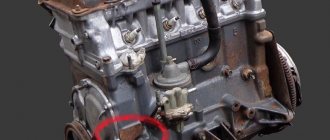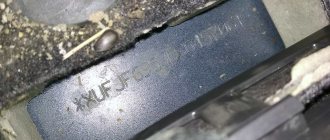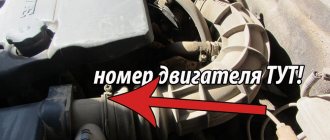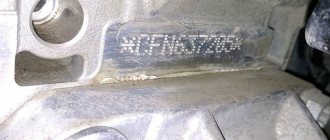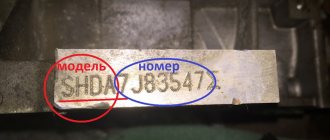The importance of numbers
In the Russian Federation, the procedure for registering vehicles and the subsequent provision of supporting documentation remains mandatory. Registration of vehicles without documents confirming compliance with current road safety standards is prohibited. Registration is important for the legal admission of a car to participate in road traffic and helps to monitor correct operation and compliance with traffic rules. At the same time, the registration documentation indicates the technical parameters and license plates of KamAZ.
What data is indicated?
A nameplate is installed on the right side of the car cabin (usually in the door opening) indicating the following information:
- data about the automobile plant, encrypted in the form of a code;
- index, which is a conventional code combination of the car model and consists of six characters, with the vehicle version indicated in the last place;
- one digit corresponding to the year of manufacture of the car;
- code combination about the car associated with the serial number at release (indicate 7 characters).
The table also indicates the following data:
- sign and number confirming the high quality of the manufactured vehicle;
- possible load permitted taking into account current safety regulations;
- engine number on a KamAZ vehicle, which includes 7 digits;
- motor model;
- power of the power unit (only the useful indicator is taken into account).
Important! Basic information is indicated in the cab number in KamAZ. Moreover, each digit has a special meaning, which is taken into account when compiling code combinations. However, to comply with standards, not only the frame number on KamAZ is important. The necessary information can be found on other parts of the vehicle, and the code combination always contains basic information about the car and a specific unit that is important for the technical performance of the car.
At the same time, the KamAZ chassis number does not indicate the following information, which is indicated only on the main plate:
- maximum possible vehicle weight;
- permitted mass that falls on the axles: front, second, third, fourth.
Any code information is indicated taking into account the actual technical characteristics of the car and accepted standards, which most motorists should remember.
Identification numbers and sealing scheme for KamAZ-5490.
Identification numbers and sealing scheme for KamAZ-5490.
Vehicle marking.
The vehicle marking must comply with the “Technical Regulations on the Safety of Wheeled Vehicles”.
Vehicle nameplate
The vehicle nameplate is installed on the right side panel of the cab in the door opening.
Vehicle factory plate.
— name of the manufacturer;
— identification number, including:
- XTS – manufacturer code;
- a – conventional code of the car model, consisting of six characters;
- b – year of manufacture code (1 character);
- c – serial production number of the vehicle (7 characters).
- – sign of circulation on the market;
- e – number of “vehicle type approval”;
- weight values : technically permissible maximum weights and permitted maximum weights.
If the technically permissible maximum mass exceeds the corresponding permissible maximum mass, then the mass values are indicated in two columns: permissible maximum mass - in the left column; technically permissible weight in the right column.
Technically permissible maximum weights:
- m – technically permissible maximum weight of the vehicle;
- m1 – technically permissible maximum weight of the road train (for tractors);
- P1 – technically permissible maximum weight on the front axle;
- P2 – technically permissible maximum weight on the second axle;
- P3 – technically permissible maximum weight on the third axle;
- P4 – technically permissible maximum weight per fourth axle.
Permitted maximum weights:
- m* – permissible maximum vehicle weight;
- m1* – permissible maximum weight of the road train (for tractors);
- P1* – permitted maximum weight on the front axle;
- P2* – permitted maximum weight on the second axle;
- P3* – permitted maximum weight on the third axle;
- P4* – permitted maximum weight on the fourth axle.
Factory plate of a vehicle for export.
The plate is installed on the right side panel of the cab in the door opening.
Factory plate of a vehicle for export.
The plate contains (see Fig. Vehicle nameplate for export):
manufacturer's name;
- e – European approval;
- d – distinctive number or letters of the country which has granted EEC type approval;
- f – EEC type approval number
identification number including:
- XTS – manufacturer code;
- a – conventional code of the car model in accordance with the technical specifications for the car, consisting of six characters;
- b – production year code according to GOST R51980-2002 (1 character);
- c – vehicle serial number (7 characters).
Mass parameters technically permissible by the design:
- m – total vehicle weight allowed by the design;
- m1 – total weight of the road train (for tractors), permissible by the design;
- P1 – weight permissible by the design on the front axle;
- Р2 – weight permissible by the design on the second axle;
- Р3 – weight permissible by the design on the third axle;
- P4 is the weight permissible by the design on the fourth axle.
- Acceptable parameters of masses permitted for registration:
- m* – total vehicle weight;
- m1* – total weight of the road train (for tractors);
- P1* – permissible weight on the front axle;
- Р2* – permissible mass on the second axle;
- P3* – permissible weight on the third axle;
- P4* – permissible weight on the fourth axle;
- manufacturer's trademark.
Engine parameters:
- g – engine serial number;
- k – engine model;
- n – useful engine power.
Features of the location of engine and frame numbers
The vehicle identification number is always located on the right side and in the rear, or more precisely, in the side member of the car frame. In this case, the KamAZ frame number can only be applied in the direction of travel. Restrictive signs must be placed on both sides.
Fact! In this case, you need to know where the frame number on KamAZ is located. This code combination is located on the right side member at the front of the car frame. The location of the cab number on KamAZ will be different: the inner panel of the front part of the cab.
The following information is required:
- vehicle frame or cabin model (6 characters);
- one digit indicating the year the car was produced;
- number combination of the frame or cabin (7 digits), which determines the date and product when the machine was released.
You also need to know where the engine number is located on KamAZ. The table with designations is installed on a specially treated area, or rather, in front of the power unit and always on the right side in the upper part.
In this case, indicate the following information about the power unit:
- code of the base motor that was originally installed;
- code that determines the version of the power unit;
- number identifying the year of manufacture of the engine;
- serial number combination.
Information is entered in 2 lines. The impact method is used for application, as this guarantees high-quality punching of numbers. In this case, the information is applied to the cylinder block.
The code combination is punched in certain areas in accordance with the vehicle layout and legal regulations. You can also read about Transmissions on KAMAZ.
The importance of car number plate designation
Article 33 determines that if the car frame number is damaged, it is impossible to register the car with the traffic police and provide license plates. For this reason, in accordance with the current legislation of the Russian Federation, an examination of the numbers is initially carried out, after which a final decision is made.
If the code combination wears out naturally, the issue can be resolved and a criminal case will not be initiated. For example, many owners of KamAZ models 5320, 43114, 43118, 53212, 55111, 65115 are faced with the fact that important data is erased during intensive use. In addition, the above models were produced in Russia for a long time and often the reasons for erasing information codes are natural.
Sometimes an examination is carried out, during which fraudulent activities related to the theft of a car are discovered. In such cases, the car is sent to a special station and an investigation begins. For example, 65117 has only been produced since 2004, so natural wear does not always occur, and each situation is considered with particular care.
Models of KAMAZ engines
The range of KAMAZ Euro-4 engines includes:
A model with a power of 280 hp (Euro-3) is 740.62-280. This option is best installed on various modifications of trucks from this manufacturer.
The new KamAZ P6 and KamAZ 910 engines can be installed on a vehicle that will have to cope with a high level of load.
KamAZ also has the following engine models: 740.63-400, 740.60-360, 740.61-320, 740.65-240, 740.31-240. They all have a similar appearance and technical characteristics that meet Euro-3 environmental standards.
Options made according to Euro-4 environmental standards:
The following models comply with Euro-1 environmental standards:
Kamaz engines manufactured according to Euro-0 standards: 7403.10 and 740.10-20.
Summary
The KamAZ-740 engine has excellent technical characteristics, which made it popular not only in Russia, but throughout the world.
Production of 740 engines continues today. The KAMAZ engine plant produces a large number of engines, and even plans to release a new engine labeled 740.80-300.
This is a 5th generation power unit with Euro-5 environmental standards, which will have a new injection system, which, according to the designers, will change the idea of turbodiesels in trucks. Power will vary from 500 to 800 horsepower.
Specifications
Technical characteristics of KamAZ engines manufactured according to various environmental standards:
| Indicators | 740.13-260 (Euro-1) | 740.51-320 (Euro-2) | 740.31-240 (Euro-3) | 820.60-260 (Euro-4) |
| Motor power (horsepower) | 260 | 320 | 240 | 260 |
| Number of crankshaft revolutions | 2200 | 2200 | 2200 | 2200 |
| Maximum torque resource, Nm | 833 | 1020 | 980 | 1078 |
| Number of cylinders | 8 | 8 | 8 | 8 |
| Arrangement of cylindrical elements | V-shaped | V-shaped | V-shaped | V-shaped |
| Diameter of the cylindrical part, cm | 12 | 12 | 12 | 12 |
| Piston stroke, cm | 12 | 13 | 12 | 12 |
| Working volume, l | 0,85 | 12 | 11 | 11 |
| Compression ratio | 16,5 | 16 | 16,5 | |
| Operating order of cylindrical parts | 1, 5, 4, 2, 6, 3, 7, 8 | 1, 5, 4, 2, 6, 3, 7, 8 | 1, 5, 4, 2, 6, 3, 7, 8 | 1, 5, 4, 2, 6, 3, 7, 8 |
| Rotation side | Right | Right | Right | Right |
| Modification of the high pressure fuel pump | 337-42.08 YAZDA | 33720-03 YAZDA | 337-20 YAZDA | 337-71 YAZDA |
| Outlet cooling system operating temperature range | +85…+90°С | +85…+90°С | +85…+90°С | +85…+90°С |
| Injectors | 273-31 | 27350 | 273-51 | 273-51 |
| Starting system | Mechanical | Mechanical | Machine | Machine |
Engine KAMAZ 6520
Before writing about the engine of the KAMAZ 6520, let’s briefly describe the vehicle itself.
A dump truck with a carrying capacity of up to 20 tons has been produced at the Kama Automobile Plant since 2002; the vehicle has six wheels, four of which are drive wheels. The purpose of the vehicle is wide, but it is primarily used for transporting bulk substances and materials. However, it is worth noting that due to its characteristics, the model occupies a certain place in road services and special equipment.
In the modern version, the following engines are installed on the KAMAZ 6520:
| Model | HP |
| Engine KAMAZ 6520 euro 2 article 740.51 -1000400 | 320 |
| Engine KAMAZ 6520 euro 2 article 740.50 -1000400 | 360 |
| Engine KAMAZ 6520 euro 3 article 740.60 -1000400 | 360 |
The KAMAZ 740.62 engine with 280 hp is also used.
Initially, the cars were equipped with 740.30 by 260 engines.
Need a 6520 motor?
Engine KAMAZ 740.30-260
- Article 740.30-1000400;
- Ecological class Euro 2, Euro 3;
- Power 260 horsepower;
- Applicability: 6520, 43118 and others;
- Fuel pump YAZDA or Bosch;
- Flywheel for single-plate clutch;
- Price from 390 thousand rubles.
Engine KAMAZ 740.51-320
- Article 740.51-1000400;
- Ecological class Euro 3;
- Power 320 horsepower;
- Applicability: 6520, 6522 and others;
- Fuel pump YAZDA or Bosch;
- Flywheel for single-plate clutch;
- Price from 390 thousand rubles.
Engine KAMAZ 740.62-280 (and models 740.60, 740.61, 740.63)
- Article 740.62-1000400;
- Ecological class Euro 3;
- Power 280 horsepower;
- Applicability: 65115, 6520 and others;
- Bosch fuel pump;
- Flywheel for single-plate clutch;
- Price from 470 thousand rubles.
The KAMAZ 6520 engine is recognized as a successful and reliable unit in operation. It is also used on other trucks and equipment from other manufacturers. Any KAMAZ 6520 engine is adapted to a cooling system with an intercooler and a modern single-disc clutch. Equipped with fuel equipment from the Yaroslavl plant or Bosch.
What does the concept of euro 2 and euro 3 mean?
The environmental class of a KAMAZ vehicle refers to the level of compliance with a certain standard. These environmental standards are generally recognized throughout the world and are followed in most countries. They mean the level of harmfulness of the car in relation to the environment in the form of emissions of the consequences of fuel breakdown and impurities.
The KAMAZ 6520 engine, designated EURO 3, was developed for operation in large cities of Russia and for export to other countries. It is known that the entry of cars into the Moscow Third Transport Ring (TTK) below Euro 2 class is prohibited. The stringency of the requirements in the document regulating this level has increased by 40% compared to the past. Now the plant has successfully launched the production of Euro-4 engines, which, by the way, are already successfully installed on the KAMAZ 6520 vehicle in the latest serial production.
Delivery cost to Russian cities
City. Approximate delivery time (days). Approximate cost (rubles including VAT).
1. Abakan, 14680 2. Alushta, 15890 3. Anapa, 8690 4. Armavir, 7670 5. Arkhangelsk, 6350 6. Astrakhan, 6080 7. Achinsk, 15200
City. Approximate delivery time (days). Approximate cost (rubles including VAT).
1. Balakovo, 9350 2. Barabinsk, 11780 3. Baranchinsky, 10000 4. Barnaul, 11690 5. Bakhchisaray, 15900 6. Belgorod, 6270 7. Belebey, 9350 8. Belogorsk (Amur region), 29730 9. Belogorsk (Republic Crimea ), 14030 10. Beloretsk, 10100 11. Beloyarsky, 23280 12. Berdsk, 10940 13. Berezniki, 7390 14. Biysk, 12530 15. Birobidzhan, 27-28, 28800 16. Blagoveshchensk (Amur region), 27-28, 29730 17. Boguchany, 11880 18. Boksitogorsk, 11220 19. Bolshaya Izhora, 6730 20. Borodino, 11-13, 17490 21. Bratsk, 14-16, 21230 22. Bryansk, 6360 23. Buzuluk, 6920
24. Vanino (Khabarovsk Territory), 35810 25. Veliky Novgorod, 8700 26. Verkhniy Tagil, 10010 27. Verkhny Ufaley, 13750 28. Verkhnyaya Salda, 10010 29. Verkhnyaya Tura, 10010 30. Vishnegorsk, 12160 31. Vladivostok, 22440 32 Vladikavkaz, 7850 33. Vladimir, 3650 34. Volgograd, 5330 35. Volzhsk, 7570 36. Volzhsky, 7010 37. Vologda, 7290 38. Volkhov, 8790 39. Voronezh, 5140 40. Vyborg, 5890 41 Vysotsk, 5890 42 Vyazma, 7950
43. Gai, 8510 44. Gatchina, 7760 45. Gelendzhik, 10570 46. Glazov, 8700 47. Gubkinsky, 21880
48. Dzhankoy, 15900 49. Dzerzhinsk, 5610
50. Evpatoria, 15900 51. Ekaterinburg, 8140 52. Yelets, 7010
53. Zheleznogorsk (Krasnoyarsk region), 11880 54. Zheleznogorsk (Kursk region), 5800
55. Zabaikalsk, 20850 56. Zelenogorsk, 11880 57. Zelenogorsk (Leningrad region), 7010 58. Zlatoust, 8980
59. Ivangorod, 8790 60. Ivanovo, 4210 61. Izhevsk, 6270 62. Irkutsk, 11-12, 15620 63. Ishim, 9540 64. Ishimbay, 8510
65. Yoshkar-Ola, 5800
66. Kazan, 5800 67. Kaliningrad, 5610 68. Kaluga, 4400 69. Kamensk-Uralsky, 8230 70. Kamensk-Shakhtinsky, 8140 71. Kansk, 11-13, 17490 72. Kasli, 12160 73. Kachkanar, 12620 7 4. Kemerovo, 11780 75. Kerch, 15900 76. Kingisepp, 8790 77. Kirishi, 8700 78. Kirov, 5520 79. Kirovgrad, 10010 80. Kirovsk, 7010 81. Kovrov, 5520 82. Kogalym, 11590 83. Kolpino , 6640 84. Komsomolsk-on-Amur, 27-28, 30200 85. Kostroma, 4960 86. Krasnodar, 6360 87. Krasnoe Selo, 1-3, 4020 88. Krasnoperekopsk, 15900 89. Krasnoturinsk, 11220 90. Krasnouralsk, 10010 91. Krasno Ufimsk, 8040 92. Krasnoyarsk, 8-9, 11880 93. Kuvandyk, 10470 94. Kuibyshev, 8-9, 11780 95. Kumertau, 9630 96. Kungur, 8040 97. Kurgan, 8700 98. Kursk, 5800 99. Kushva, 100 10 100 Kyzyl, 12-14, 18420 101. Kyshtym, 11780
Device
The KamAZ engine structure includes the following elements:
- Cylindrical block made of cast iron alloy. The crankcase surface is connected to the main bearing cap and coupling bolts. In the crankcase there are guides of the pusher elements, and the bypass pipe of the cooling cavity is also located here.
- Sleeves of cylindrical parts. They are made of a special cast iron alloy with an increased level of hardening.
- Drive units. It consists of spur gears. Such a drive is necessary for the gas distribution mechanism, injection pump, compressor and power steering pump.
The engine structure in longitudinal section includes:
- high pressure fuel pump;
- compressor element;
- fine fuel filter;
- crankcase units;
- turbo compressor;
- flywheel;
- crankshaft;
- oil type crankcase;
- piston part cooling nozzles;
- drive pulley for heater, generator and water pump;
- fan;
- mounting bracket;
- gears.
Where is the engine number
The engine number can be found on the information plate, which is located on the right at the top of the front surface of the engine.
Engine operating order
The order of operation of the cylindrical mechanisms is a component of the operation of the motor. The cylinders in this unit operate in the following order: 1, 5, 4, 2, 6, 3, 7, 8.
Engine operating principle:
- A clean air flow enters the cylindrical part of the diesel engine.
- The flow begins to decrease with a high degree of compression, which causes pressure and temperature to increase.
- At the end of the compression procedure, finely atomized fuel liquid is injected into the heated air flow from the nozzles.
- The liquid ignites upon contact with a hot air flow.
- During the injection process, a working mixture is formed.
- During the movement of the piston part to BDC, a vacuum occurs in the cylinder.
- The intake valve opens, allowing the cylinder to fill with air.
- After this, the air flow is mixed with the remaining exhaust gases.
- The piston begins to move to TDC, the intake and exhaust valves close.
- The piston part displaces gases from the cylinder block.
Search
KAMAZ engine 740: design and repair
KamAZ trucks began to be produced in 1969. For the latest generation of trucks, engineers produced a 4-stroke KamAZ-740 V8 diesel engine. the power supply had a volume of 10852 cm3 and a power of 210 horsepower. Then the power characteristics had to be expanded from 180 hp. up to 360. These trucks were equipped with a pneumatic power steering, 5-speed gearbox with synchronizers.
Diesel unit design
The design of these engines, if we connect them to other diesel engines, has some advantages. The device has a relatively small size and also has the smallest weight compared to the same NMZ 238.
Torque from the engine to the main units is transmitted by a screw mechanism. Yes, transmissions have gas distribution systems, pumps and compressors, as well as a power amplifier.
This engine (Kamaz 740) has good starting even at very low ambient temperatures. This is made possible by powering the batteries, starters and heating systems before starting.
Engine Specifications
The model of the power plant was named Kamaz 740 diesel. The cylinders are V-shaped. The crankshaft rotates to the right. The depth and depth of the cylinders is 120 mm. 120 mm. Engine Kamaz 740 with a volume of 10.85 liters. has the highest compression ratio. 17. Nameplate power in kW ranges from 154 to 210. Maximum torque. 650 kgf/m Low fuel consumption - 165 liters, the highest. 178 liters Each cylinder has one intake valve and therefore one exhaust valve.
Let's look at the Kamaz 740 engine , the design of various components and systems.
Cylindrical block
This device is nothing more than a part of the block body. It is designed to install and protect all devices and major systems. The cylindrical block is made in the form of a monolithic structure. The parts have technological holes, as well as channels for lubrication and cooling.
Sleeve sockets are located at the top of this device. The housing is also equipped with channels and cavities for the passage of cooling water. The lower part of the cylinder block also serves as crankcase protection. The crankshaft was immediately installed. There are two oil holes in the pan. Inside the unit there are partitions with special rigidity. Special holes are made in these partitions and crankcase walls, which are closed with covers. These parts serve to support the crankshaft.
The unit is equipped with camshaft supports and also has cam followers.
The sleeves serve as guides for the pistons. Together with the block head, they form a special cavity, which is a fuel burner. The sleeves are made of special cast iron and electrically hardened.
You may also like
The highest part of the aircraft is represented by the cylinder heads. Any of them with their own heads. These parts are made of aluminum. Each head has a cooling jacket inside, which in turn is connected to a jacket block. Also on any head there are lubrication holes, inlet and outlet valves, and a special outlet pipe for the nozzle.
Contract of numbers before purchasing KAMAZ
When purchasing commercial vehicles and registering them, the question often arises: where is it?
VIN codes - where to find them on different models of special equipment?
Overview of the device and technical characteristics of KAMAZ 740 ENGINE
.
Lubrication system design and operation
The Kamaz 740 engine is equipped with a combined lubrication system. Depending on where the rubbing parts are located and under what conditions the oil is supplied differently. The system may spray, supply low pressure oil, or leak oil.
The device supplies oil under pressure to parts that are more susceptible to wear in particularly busy warehouses. This unit consists of main and oil storage units, filtration and supply units, and oil cooling units.
Malfunctions and repairs
Engine malfunctions can be caused by improper operation of the vehicle, for example, the driver did not carry out maintenance on time, did not comply with the speed limit, etc.
Procedure for repairing a KamAZ (Euro-2) engine if it does not start:
- Air may have entered the fuel supply system. It is necessary to eliminate the leak and bleed the system.
- The fuel injection advance angle was violated. The angle needs to be adjusted.
- Water got into the fuel pipes and froze. The filter elements and tubes should be heated using steam. The use of open fire is prohibited. An oil change may be required.
Stopping the KamAZ engine may be associated with the following breakdowns:
- Improper driving. The motor needs to be checked. If there is no damage, you need to start the engine and continue working, following all the recommendations in the user manual.
- Increased crankshaft speed. This problem can only be solved at a service center.
Error codes
Error codes can be obtained by pressing a button located under the steering wheel or on the fuse panel.
Why does it knock, vibrate and shake?
If the engine knocks, it is recommended to adjust the fuel injection advance angle. Also, the reasons for the knocking may be:
- Increased clearances in the gas distribution mechanism. It is necessary to adjust the gaps, check the pusher plates for wear (if necessary, replace them with new ones), and inspect the mechanism for damage and deformation.
- Valve mechanism. You need to take it apart and wash it. If the rod is bent or the spring is broken, they should be replaced.
- The appearance of an imbalance. In this case, repair of the cylinder block will be required. After replacing the failed elements, the problem will disappear.
- Broken crankshaft.
- Incorrectly set timing marks. In this case, gas exchange is disrupted and the cylinders begin to operate unstably.
- The torsional vibration damper is damaged.
If the engine shakes, it means:
- When replacing the crankshaft, the flywheel and clutch basket were not balanced.
- The cylindrical element has failed.
- The pressure valve in the high pressure fuel pump needs to be replaced.
- The injectors need to be swapped.




